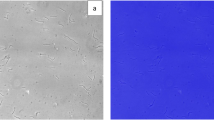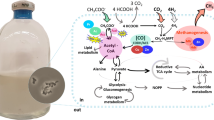Abstract
A methanogenic bacterium using H2 and CO2 as sole energy and carbon source has been isolated in pure culture from digested sludge. Its colonies on mineral agar are translucent, convex, circular with entire margins and yellow to brownish in colour. Cells are gram-positive, non motile and appear as straight cods, normally about 3 μm long. A marked pleomorphism depending on the media was observed. The organism is chemolithoheterotrophic, has a pH optimum of 7.0 and an optimal temperature for growth of 33–40°C; no growth occurs above 45°C. The generation time at optimal conditions is less than 5 h. Cysteine must be supplied in the growth medium. It can act as sole sulfur source. The addition of sulfide accelerates the growth at an optimum concentration of 10-4 to 10-5 molar. A growth factor, not identical with SH-coenzyme M, occurring in anaerobic sewage sludge and yeast extract shows a stimulatory effect. 7.0–8.2% of the total carbon dioxide uptake is assimilated and 11.2% of the energy obtained from the reduction of carbon dioxide to methane is refound in the caloric value of the biomass. 0.01 ppm of dissolved oxygen completely inhibits growth and methane production. However, the bacteria do not loose their viability when exposed to high oxygen concentrations. Further informations are needed before this organism (DSM 744) is specifically identified.
Similar content being viewed by others
Abbreviations
- TOC:
-
total organic carbon
- DOC:
-
dissolved organic carbon
- POC:
-
particulate organic carbon
References
Berner, W., Bucher, P., Oeschger, H., Stauffer, B.: Analysis and interpretation of gas content and composition in natural ice. Symp, on isotopes and impurities in snow and ice: Union géodésique et géophysique internationale, Grenoble, le 25/8-6/9 (1975)
Bryant, M. P.: Methane-producing bacteria. In: Bergey's manual of determinative bacteriology, 8th ed. (R. E. Buchanan, N. E. Gibbons, eds.), pp. 472–477. Baltimore: Williams and Wilkins 1975
Bryant, M. P., Robinson, I. M.: An improved nonselective culture medium for ruminal bacteria and its use in determining diurnal variation in numbers of bacteria in the rumen. J. Dairy Sci. 44, 1446–1456 (1961)
Bryant, M. P., Tzeng, S. F., Robinson, I. M., Joyner, A. E., Jr.: Nutrient requirements of methanogenic bacteria. In: Anaerobic biological treatment processes. Advances in Chemistry, Series 105 (F. G. Pohland, ed.), pp. 23–40. Washington, D.C.: Am. Chem. Soc. 1971
Bryant, M. P., Wolin, E. A., Wolin, M. J., Wolfe, R. S.: Methanobacillus omelianskii, a symbiotic association of two species of bacteria. Arch. Mikrobiol. 59, 20–31 (1967)
Hungate, R. E.: The anaerobic mesophilic cellulolytic bacteria. Bact. Rev. 14, 1–49 (1950)
Hungate, R. E.: The rumen and its microbes, p. 78. New York-London: Academic Press 1966
Hungate, R. E.: A roll tube method for cultivation of strict anaerobes, In: Methods in microbiology, Vol. 3 B (J. R. Norris, D. W. Ribbons, eds.), pp. 117–132. New York-London: Academic Press 1969
Larson, T. E., Buswell, A. M.: Calcium carbonate saturation index and alkalinity interpretations. J. Amer. Water Works Ass. 34, 1667–1684 (1942)
Latimer, W. M.: Oxidation potentials, 2nd ed. Englewood Cliffs, N.J.: Prentice-Hall 1956
Paynter, M. J. B., Hungate, R. E.: Characterization of Methanobacterium mobile, sp.n., isolated from the bovine rumen. J. Bact. 95, 1943–1951 (1968)
Roberton, A. M., Wolfe, R. S.: Adenosine triphosphate pools in Methanobacterium. J. Bact. 102, 43–51 (1970)
Smith, P. H., Hungate, R. E.: Isolation and characterization of Methanobacterium ruminantium n.sp. J. Bact. 75, 713–718 (1958)
Stadtman, T. C.: Methane fermentation. Ann. Rev. Microbiol. 21, 121–142 (1967)
Stumm, W., Morgan, J. J.: Aquatic chemistry. New York-London-Sydney-Toronto: Wiley 1970
Taylor, C. D., Wolfe, R. S.: Structure and methylation of coenzyme M. J. Biol. Chem. 249, 4879–4885 (1974)
Wolin, E. A., Wolin, M. J., Wolfe, R. S.: Formation of methane by bacterial extracts. J. Biol. Chem. 238, 2882–2886 (1963)
Zehnder, A. J. B.: Oekologie der Methanbakterien, Dissertation, ETHZ, Nr. 5716. Zürich: Juris 1976
Zeikus, J. G., Henning, D. L.: Methanobacterium arbophilicum sp. nov. An obligate anaerobe isolated from wetwood of living trees. Antonie v. Leeuwenhoek 41, 543–552 (1975)
Zeikus, J. G., Wolfe, R. S.: Methanobacterium thermoautotrophicum sp.n. An anacrobic, autotrophic, extreme thermophile. J. Bact. 109, 707–713 (1972)
Author information
Authors and Affiliations
Rights and permissions
About this article
Cite this article
Zehnder, A.J.B., Wuhrmann, K. Physiology of a Methanobacterium strain AZ. Arch. Microbiol. 111, 199–205 (1977). https://doi.org/10.1007/BF00549357
Received:
Issue Date:
DOI: https://doi.org/10.1007/BF00549357




